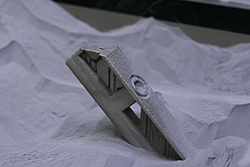|
March 2019
The Future of Metal AM: Industry Integration Trends
Mark Barfoot
The additive manufacturing (AM) industry is predicted to grow exponentially over the next decade as companies aim to consolidate parts, create geometries that can’t be made any other way, and provide customization that was never possible before.
Metal AM has seen significant hype in the past few years and, as with any hype curve, many of you may be struggling to understand what is real right now and what is media buzz. To help you weed through these details, we’ve identified six key AM trends in manufacturing:
1) Increase in AM powder metal suppliers. With many new providers in the marketplace users have a wider selection from whom to purchase powder. These metal material companies are also introducing a variety of exciting new alloys/materials for AM.
2) Introduction of lower cost metal additive technologies. New extrusion-based metal technologies (i.e.: from Desktop Metal, Markforged) are capable of building net parts using an extrusion head similar to FDM technology, then sintering in an oven to complete part solidification. We also are seeing more development in binder jetting which utilizes an ink jet print head to spray on a binder. Although the technology has been around for a while, there are new entries to the market that could be a fit for many industries because they can print faster and more efficient that existing systems.
 3) A wider range of L-PBF systems. Many machine manufacturers moving into the laser powder bed fusion (L-PBF) market, some offering a much lower cost L-PBF system. For example, Xact Metal offers a system with reduced capacity, but it brings the machine cost below the $150k price point. 3) A wider range of L-PBF systems. Many machine manufacturers moving into the laser powder bed fusion (L-PBF) market, some offering a much lower cost L-PBF system. For example, Xact Metal offers a system with reduced capacity, but it brings the machine cost below the $150k price point.
4) A focus on standards and process development. The need for broadly accepted standards prompted ASTM to create the AM Center of Excellence (COE) in 2018. As a founding member of the center, EWI is deeply involved in efforts to advance standards development as manufacturers push for better quality and repeatability.
5) Advanced process monitoring and control technologies. Many machine vendors have started incorporating melt pool or in-process monitoring into their processes. The goal is to create quality systems to ensure parts produced are accurate and error-free.
6) Hybrid machines. Several systems can now integrate additive manufacturing with traditional (subtractive) machining to improve accuracy and/or surface finish of parts.
As metal AM becomes more accepted and integrated into mainstream production, manufacturers in all sectors are striving to understand how to best use the technology for their purposes. In response, EWI is working to re-assess the AM service needs of our members.
If you have already integrated AM technology at your company, are there productivity or process issues that remain a challenge? If you are now getting started with AM technology, do you need assistance in identifying the right AM processes for your application? Or are you just thinking about integrating AM production methods and wondering where to begin?
To be able to address your challenges and goals, we are asking EWI members to complete a brief survey about AM adoption in your organization. Your comments will help us understand how we can provide the services you are looking for to meet the challenges ahead. To complete the survey, click here.
|